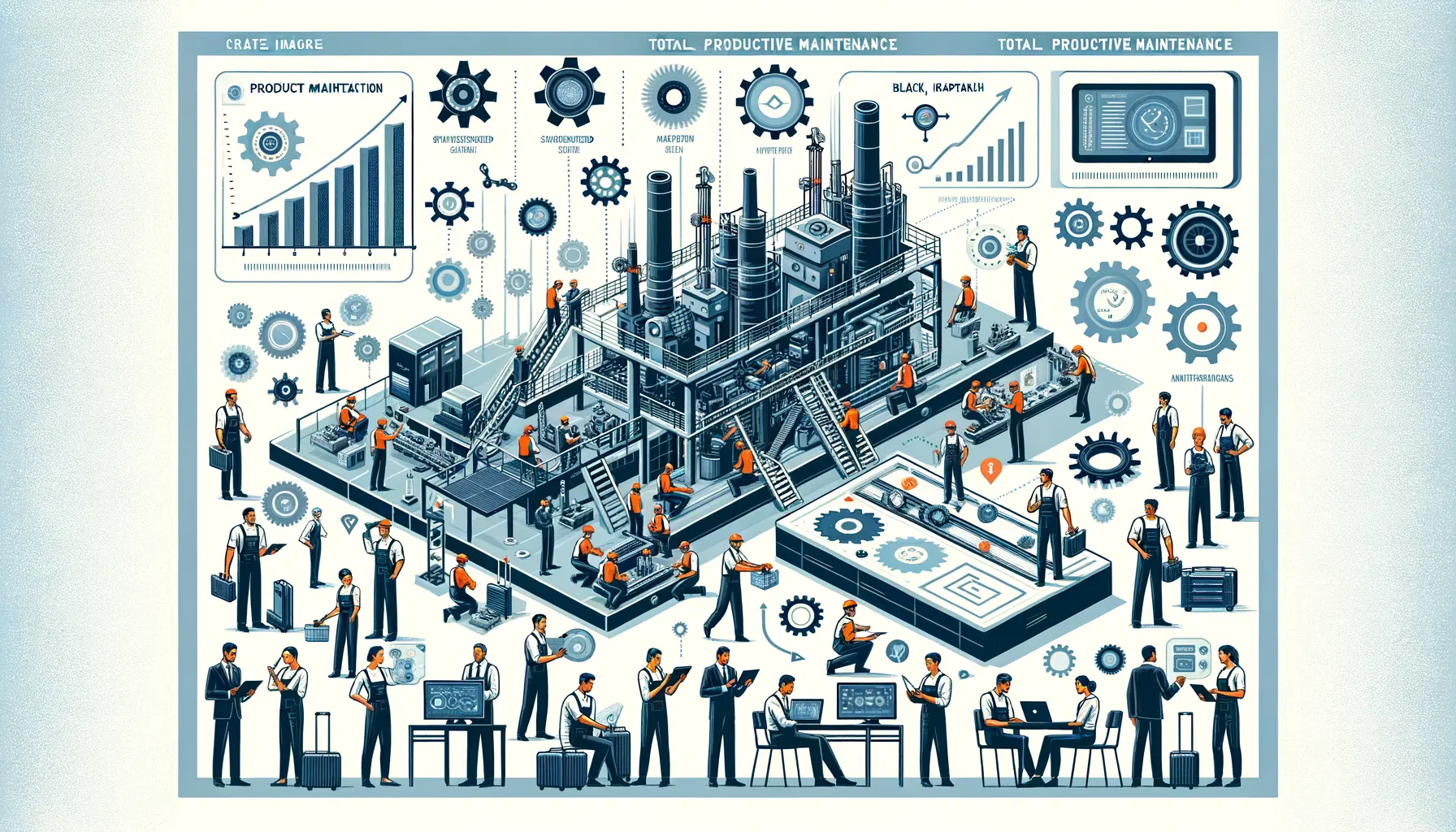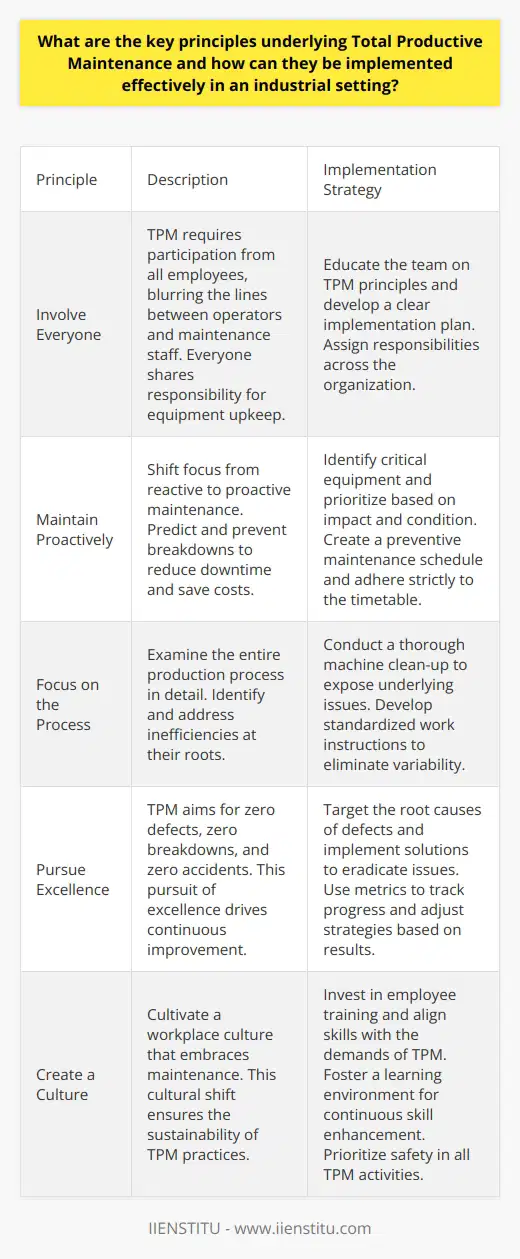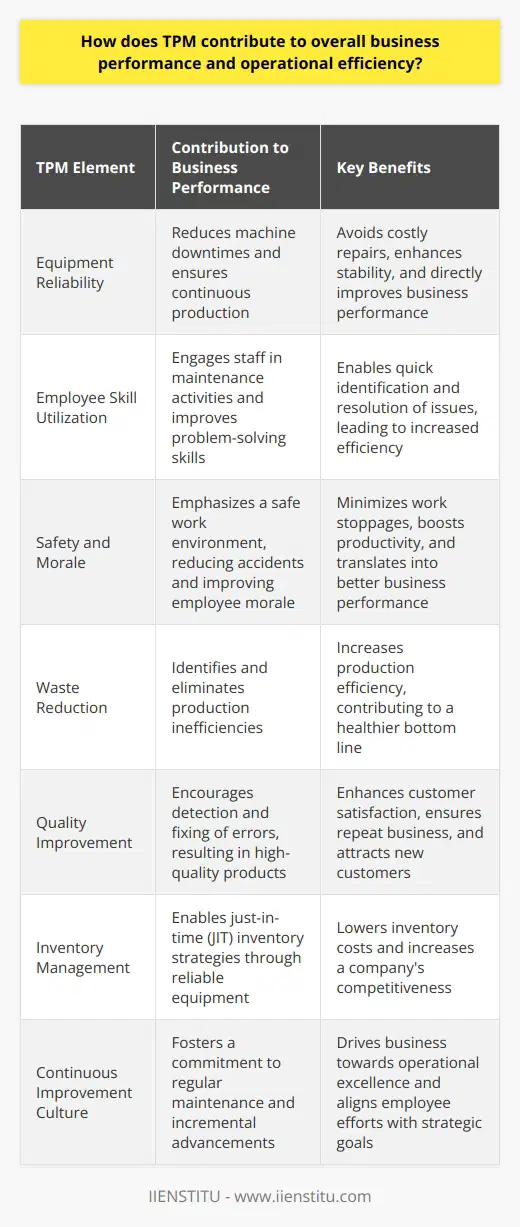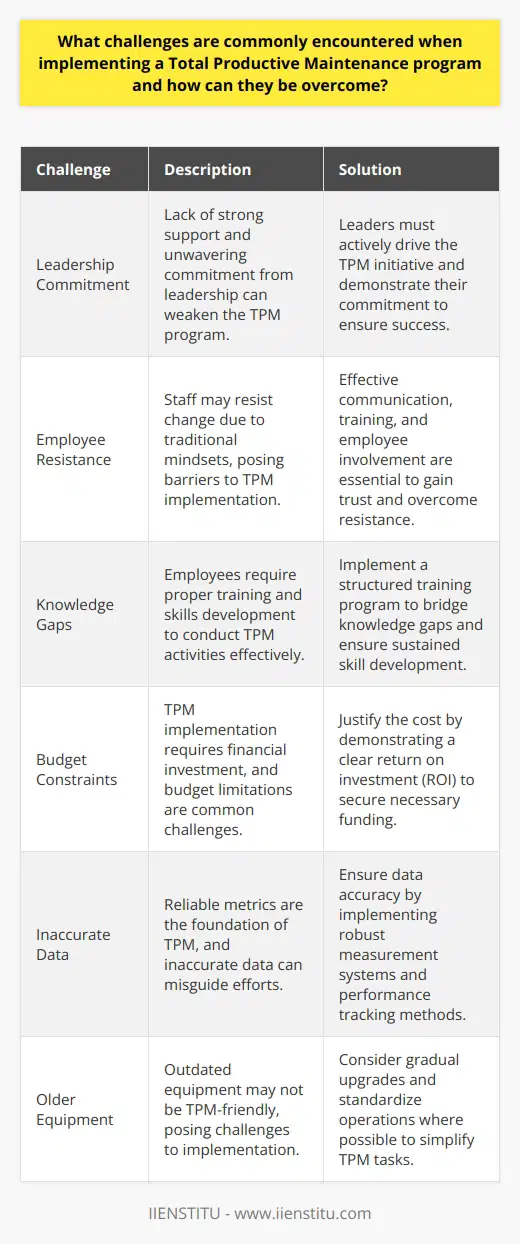
Total Productive Maintenance (TPM) is a holistic and structured approach to enhancing equipment effectiveness in manufacturing systems. It emphasizes preventive maintenance, the involvement of all employees, and a long-term commitment to continuous improvement. Originating in Japan in the 1970s, TPM has since evolved and integrated itself within the lean manufacturing principles observed worldwide. In today's industrial environment, the importance of TPM cannot be overstated, as it significantly contributes to an organization's productivity, quality, and overall operational excellence.
Philosophy and Principles of TPM
Analyzing the core philosophy of TPM
The core philosophy of TPM revolves around three key elements: Continuous Improvement, Involvement of all staff, and the pursuit of Zero Defects, Breakdowns, and Accidents. This implies a relentless pursuit of perfection, encouraging a company culture that enthusiastically identifies and rectifies flaws in production processes.
Continuous improvement emerges from the Kaizen approach, believing that the best way to achieve significant results is through a series of small, incremental changes. Involvement of all staff signifies that TPM is not solely a maintenance department initiative but a shared responsibility across the organization. The goal is an ambitious yet vital one: eradicating inefficiencies and errors at the root to ensure smooth and safe production flows.
Discussing the foundational principles underlying TPM
TPM is underpinned by several foundational principles, notably Autonomy, Total Quality Control, and an Integrated Approach. Autonomy involves educating and empowering operators to maintain their equipment, typically referred to as Autonomous Maintenance.
Total Quality Control reiterates that quality maintenance is not just about keeping machines running; it is also about upholding stringent quality standards throughout operation processes. The Integrated Approach emphasizes that TPM is not an isolated program but one that synergizes with other organizational systems and practices, particularly those linked with quality management and lean methodologies.
Zero Defects, Breakdowns, Accidents
The ultimate objective of TPM is to foster a work environment free from defects, machine breakdowns, and accidents. The notion here extends beyond mere aspiration; it is a strategic component of the TPM philosophy, with structured methodologies to guide its realization. This involves routine and preventive maintenance, systematic analysis of defects, and safety protocols meant to eliminate near-misses, as well as accidents.
Critical Chain Project Management: Enhancing Efficiency in Task Execution
Risk Mitigation: An Essential Strategy for Successful Project Management
The emphasis on preventing problems before they occur is an invaluable strategy that saves time, resources, and even lives, positioning TPM as a crucial player in the modern industrial playbook.
The Eight Pillars of TPM
Description and purpose of each pillar
TPM is structured around eight key pillars, each addressing distinct aspects of maintenance and production:
Autonomous Maintenance: Empowering operators to perform basic maintenance tasks and recognize potential issues.
Planned Maintenance: Developing and adhering to regular and systematic maintenance schedules.
Quality Maintenance: Focusing on defect prevention through proper machine operation and maintenance.
Focused Improvement: Small groups work diligently to improve equipment reliability and performance.
Education and Training: Equip employees with the knowledge and skills needed to carry out TPM-related activities effectively.
Early Equipment Management: Focusing on designing new equipment that is reliable, maintainable, and safe from the onset.
Safety, Health, Environment: Ensuring a safe and healthy work environment and minimizing the ecological footprint.
Administrative Support: Streamlining administrative functions to support production and maintenance processes.
Illustrating their interconnections with examples
The interplay between the eight pillars of TPM is key to its comprehensive approach. An example of this includes how Autonomous Maintenance leads to a better understanding of machine health, which in turn improves Planned Maintenance activities. Workers knowledgeable about their machinery can provide actionable insights for equipment improvements under the Focused Improvement pillar.
Mastering The 5 Whys Technique For Profound Problem-solving İnsights
Critical Thinking Skills For Personal And Professional Growth
Consequently, as equipment reliability increases, the workload on the administrative support required to deal with breakdowns reduces, illustrating the interconnected nature of TPM pillars.
Discussing the benefits and challenges associated with each pillar
While each pillar presents numerous benefits—such as increased equipment availability, enhanced production quality, and a safer work environment—they also bring challenges. Adjusting to the cultural shift necessary for Autonomous Maintenance can be a trial for operators traditionally not tasked with maintenance.
Implementing a robust Planned Maintenance schedule necessitates comprehensive planning and potential short-term productivity loss. However, overcoming these challenges leads to greater long-term efficiency and reinforces the viability of TPM in a competitive manufacturing landscape.
The Potential Impact of TPM
Impact on Operational Performance
The implementation of TPM has a direct and measurable impact on operational performance. Increased productivity results from both improved equipment effectiveness and a reduction in time lost to breakdowns and faults. Cost reduction is achieved as a natural consequence of better maintenance practices, leading to decreased need for repairs or replacements and lower waste production. Improved quality of the final product comes from fewer defects and interruptions, ensuring a consistent and reliable manufacturing process.
Impact on Organizational Culture
The transformative potential of TPM extends beyond the production floor into the sphere of organizational culture. Employees experience enhanced morale as they contribute to maintenance and problem-solving activities, instilling a sense of ownership and responsibility.
The embrace of TPM facilitates the formation of a continuous improvement culture, fundamentally changing how employees perceive their roles and responsibilities, fostering a proactive approach towards problem identification and resolution.
Measuring TPM effectiveness: metrics and tools
Effectiveness of TPM can be gauged through various metrics and tools aimed at evaluating improvements in machine reliability, maintenance schedules, and downtime reduction. Key Performance Indicators (KPIs) such as Overall Equipment Effectiveness (OEE), Mean Time to Repair (MTTR), and Mean Time Between Failures (MTBF) become vital in measuring the impact of TPM. Regular audits, performance reviews, and continuous monitoring ensure the constant refinement of TPM practices and their alignment with the organization's operational goals.
In concluding our comprehensive journey through Total Productive Maintenance, it's clear that TPM extends far beyond simple machine upkeep—the philosophy dictates a culture of pervasive commitment to operational excellence. As manufacturing sectors keep evolving, the relevance of TPM — with its proven track record of enhancing efficiency and engendering a proactive work culture — remains unshaken. With the rapid advance of technology and the increasing complexity of production systems, new trends and implications continue to emerge, making the adoption of TPM an ongoing and dynamic process pivotal to sustained industrial success.
Frequently Asked Questions
What are the key principles underlying Total Productive Maintenance and how can they be implemented effectively in an industrial setting?
Understanding Total Productive Maintenance (TPM)
Total Productive Maintenance stands as a core industrial improvement concept. It focuses on proactively maintaining equipment to enhance productivity. TPM extends beyond traditional maintenance. It integrates a holistic approach involving all employees.
Key Principles of TPM
TPM rests on several foundational principles. Understanding these is critical. They drive the program’s effectiveness.
Involve Everyone
TPM demands all hands on deck. It blurs the lines between operators and maintenance staff. Everyone shares responsibility for equipment up-keeps.
Empower Operators
Operators become frontline maintainers. This empowerment improves machine care regularity and reaction times to issues.
Maintain Proactively
Shift from reactive to proactive maintenance. Predict and prevent breakdowns. This reduces downtime and saves costs.
Focus on the Process
Every detail matters. Look at the entire production process. Find and fix inefficiencies at their roots.
Pursue Excellence
TPM aims for zero defects, zero breakdowns, and zero accidents. This pursuit of excellence drives continuous improvement.
Create a Culture
Cultivate a workplace culture that embraces maintenance. This cultural shift ensures sustainability of TPM practices.
Implementing TPM Effectively
Successful TPM implementation follows a structured approach:
- Educate the team on TPM principles.
- Develop a clear implementation plan.
- Divide the plan into manageable phases.
- Assign responsibilities across the organization.
Identifying Equipment
Start with critical machines.
Prioritize based on impact and condition.
Begin raising the maintenance standards with these units.
Initial Cleaning
Conduct a thorough machine clean-up.
Expose underlying issues.
Fix revealed problems to improve baseline performance.
Standardized Work
Develop clear instructions for all tasks.
Standardize work to eliminate variability.
Ensure everyone understands the exact procedures.
Planned Maintenance
Create a preventive maintenance schedule.
Adhere strictly to this timetable.
Adjust plans based on machine performance data.
Quality Maintenance
Target the root causes of defects.
Implement solutions to eradicate these issues.
Monitor results to ensure quality improvements.
Training and Development
Invest in employee training.
Align skills with the demands of TPM.
Foster a learning environment for continuous skill enhancement.
Safety First
Prioritize safety in all TPM activities.
Encourage immediate reporting of hazards.
Remove risks to prevent accidents.
Performance Measurement
Use metrics to track progress.
Select measurements that reflect TPM goals.
Adjust strategies based on these metrics.
Sustaining TPM
Implementing TPM is just the beginning. Maintenance becomes a part of the culture. Continuous improvement ensues. Feedback loops become embedded into routines. Lessons learned shape future actions. The result is a resilient, efficient production system. Sustained TPM leads to reliable equipment, satisfied employees, and improved bottom lines.

How does TPM contribute to overall business performance and operational efficiency?
The Role of TPM in Business Performance
Total Productive Maintenance (TPM) is a methodology. It enhances operational efficiency. Manufacturing industries primarily use it. However, its principles apply broadly. TPM aims for the perfect production process. It focuses on several key elements. Equipment availability, performance efficiency, and quality rate are crucial. Each of these impacts overall business performance.
TPM Increases Equipment Reliability
TPM reduces machine downtimes. It involves regular maintenance. The goal is to avoid sudden breakdowns. Scheduled maintenance takes less time. It is less costly than major repairs. Equipment reliability ensures continuous production. This stability directly enhances business performance.
Effective Use of Employee Skills
TPM actively involves employees. Staff engage in maintenance activities. They gain a better understanding of their machines. Problem-solving skills improve. Employees can identify potential issues quickly. They fix minor issues promptly. Companies benefit from the increased skill set. The overall efficiency reflects these improvements.
Safety and Morale
TPM emphasises a safe work environment. Safe workplaces reduce accidents. This leads to fewer work stoppages. Employee morale also improves. A motivated workforce is more productive. Higher productivity translates into better business performance.
Waste Reduction
TPM helps in identifying waste. Wastes are production inefficiencies. They cost businesses money. TPM seeks out these inefficiencies. It eliminates them. Less waste means higher production efficiency. Efficient operations contribute to a healthier bottom line.
Quality Improvement
Quality is essential. TPM emphasizes quality control. It encourages the detection and fixing of errors. High-quality products please customers. Customer satisfaction is key to business success. Thus, quality improvements are beneficial. They ensure repeat business and new customers.
Inventory Management
TPM can lead to better inventory management. Just-in-time (JIT) inventory strategies depend on reliable equipment. Reliable equipment ensures a steady production flow. This means lower inventory costs. Lower costs can increase a company’s competitiveness.
Fostering a Culture of Continuous Improvement
TPM is not a one-time process. It is continuous. The commitment to regular maintenance brings constant improvements. These incremental advancements add up. Over time, they make a significant impact. This culture drives business towards operational excellence.
TPM is a comprehensive approach. It maximizes the effectiveness of business operations. The impacts are far-reaching. Businesses that adopt TPM often see marked improvements in their performance. It is a method that fuels the drive for operational excellence. It aligns employee efforts with the company's strategic goals. TPM is a worthy investment for business efficiency and performance.

What challenges are commonly encountered when implementing a Total Productive Maintenance program and how can they be overcome?
Total Productive Maintenance (TPM) aims to maximize plant and equipment effectiveness. It involves every employee at all levels. However, TPM implementation faces many challenges. Understanding and addressing these issues is key for successful adoption.
Buy-in and Culture Change
Leadership Commitment
Strong support from leadership is crucial. Leaders must show unwavering commitment. They must drive the TPM initiative. Lack of leadership buy-in weakens the program.
Employee Resistance
Staff may resist change. Traditional mindsets pose barriers. Effective communication aids in gaining trust. Training and involvement are essential.
Training and Skills Development
Knowledge Gaps
Employees need proper training. They require skills to conduct TPM activities. Knowledge gaps hinder progress. A structured training program can bridge these gaps.
Sustained Skill Development
TPM demands continual learning. Employees must constantly upgrade their skills. Continuous education ensures sustained TPM benefits.
Resource Allocation Challenges
Budget Constraints
TPM needs financial investment. Budget limitations are common. Justifying the cost often requires a clear ROI demonstration.
Time and Workload Management
Employees juggle TPM tasks with regular duties. Allocating time can be difficult. Rescheduling work and setting priorities may help.
Data and Performance Measurement
Inaccurate Data
Reliable metrics are the foundation of TPM. Inaccurate data misguides efforts. Ensuring data accuracy is critical.
Performance Tracking
Measurement systems must track improvements. Ineffective systems can hinder progress. Adopting a robust tracking method is imperative.
Equipment and Infrastructure Issues
Older Equipment
Outdated equipment poses challenges. Such machinery might not be TPM-friendly. Considering gradual upgrades is a solution.
Lack of Standardization
Inconsistency in machines and processes exists. Standardizing operations simplifies TPM tasks. Implement standard procedures where possible.
Implementing TPM presents multiple challenges. These include leadership buy-in, culture change, training, resources, data accuracy, and equipment issues. Overcoming these requires a strategic approach. Active involvement of all stakeholders is mandatory. Proper planning and execution lead to successful TPM implementation.



